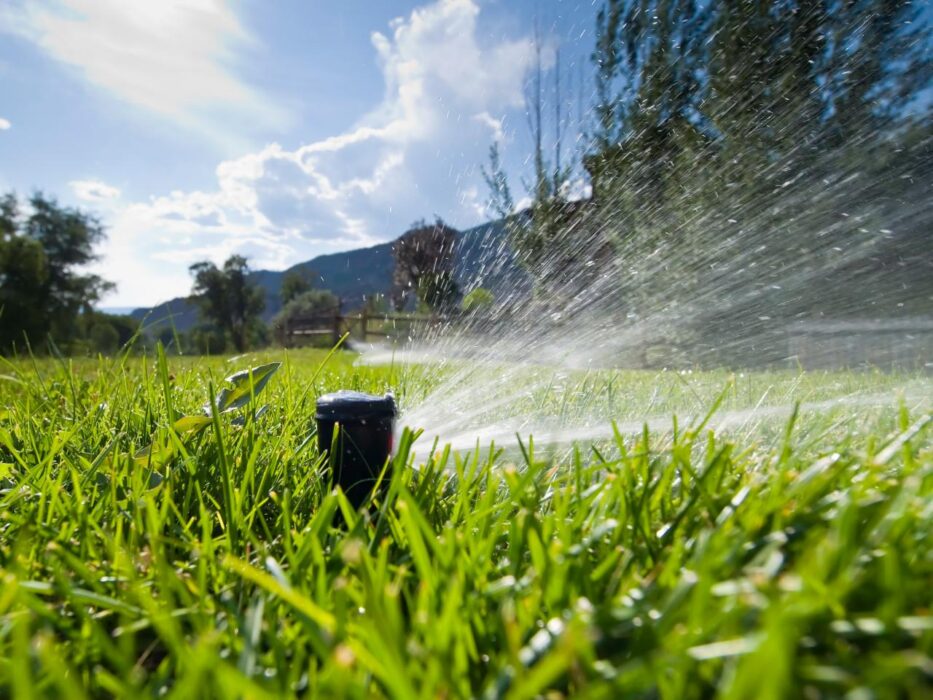
Pop-Up Sprinkler Kits In Kenya
Grekkon Limited’s pop-up sprinkler kits in Kenya are designed for lawns and gardens. As a lawn irrigation company in Kenya, we design your lawn irrigation system layout, then install your pop up sprinklers. Our pop-up sprinklers have inlet sizes of; 1/2″, and 3/4″. This inlet size determines the amount of water discharged, and the pop up sprinkler radius
Components of a Lawn Irrigation Kit
- Electric surface water pump. The size of the electric water pump, and motor power is determined by the area under irrigation
- HDPE pipe; your HDPE pipe diameter size is from 32mm (1″) in diameter to 63mm/ 2″ depending on the size of the area under irrigation. The pipe’s thickness is PN8 through PN16 depending on the pressure power of the electric water pump
- HDPE fittings; 32mm (1″) tees, elbows, adaptors and end caps. They connect the HDPE pipe to the water pump, to each other, and to the pop-up sprinklers
- Timer. This is for an automated system. It switches the pop-up sprinkler irrigation system on and off according to the timings set
Pop-up Sprinkler Kits Price In Kenya
Pop-up Kit Prices Tabulation
Area In Meters Square Number of Pop up Sprinklers Pop up Sprinkler Inlet Size Cost In Kes 50 1 1/2″ 12,000 100 1 3/4″ 18,000 500 (1/8 acre) 5 3/4″ 75,000 1,000 (1/4 acre) 9 3/4″ 125,000
The given pop-up sprinkler kits cost includes an electric water pump
Types of Pop-Up Sprinklers
There are 2 types of pop-up sprinklers by Grekkon Limited
Spray irrigation heads
Spry irrigation heads have a working pressure of 14M to 20M head. They they are for small to medium sized spaces. Each is placed at a maximum distance of 4.5M from each other. Spray irrigation heads give out a fine mist, fast, and irrigate evenly. They are not recommended on windy days or windy locations
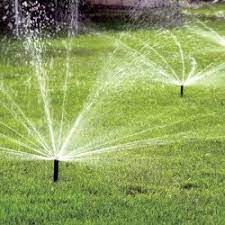
Spray irrigation head pop up sprinklers
Spray rotary heads
They are rotary with a working pressure from 20M head, and are for medium to large spaces. This is because they deliver water slowly in a stream, instead of a fine mist. Spray rotary heads are good for slow draining soils and slopes. Their spacing is from 6M
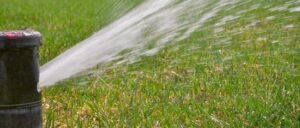
Spray rotary head pop-up sprinkler
Pop-Up Sprinklers Spacing
As shown above, the sprinkler spacing is a factor of the type of sprinkler, and also the size. Sprinklers’ spray will overlap to avoid ‘dry blind spots’
 The spray jet from each sprinkler should extend to the other sprinkler for full coverage
The spray jet from each sprinkler should extend to the other sprinkler for full coverage
How To Install Pop-Up Sprinklers
Our sub-surface pop-up sprinklers kit is piping is 40cm below ground level as illustrated below
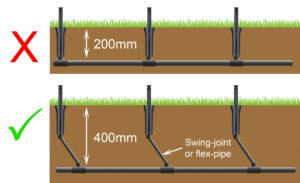
The sprinklers have laterals to a HDPE main line. This pipe’s diameter is according to the amount of water needed
The laterals from the main line carry water to the sprinklers. This depth secures the pipes against damage from the surface
Steps To Repair A Pop-up Sprinkler Head
When pop-up sprinklers age, the heads will sometimes, get stuck in position so it doesn’t rotate, chip or break. If this oocurs, follow these steps below to fix your pop-up sprinkler head
- Cut out a circular area around the pop-up sprinkler, about 15cm to 20cm in diameter
- Remove the intact grass around the sprinkler. This way, you’ll return it as it was after the repairs to the same location
- Unscrew the faulty sprinkler from it’s rider
- Replace the old head with a new one of a similar size
- Screw back the new sprinkler
- Adjust the new sprinkler head to direct the spray where you need it
- Turn on the water to test the new sprinkler, to remove any dirt/ debris, and to check for any leakages on your new connection
- Return the cut out grass
Pop-up Sprinkler Kits In Kenya
FAQs
1. How deep do pop-up sprinklers need to be?
Not more than 40cm below surface. This avoids accidental punctures of the pipe, and allows easy assessment or improvement
2. How many pop-up sprinklers can you put on one zone?
The number of pop-up sprinklers installed by Grekkon Limited in a unit area are a factor of;
2.1. Pop-up sprinkler inlet diameter/ size. The larger the diameters, the lessor the units needed
2.1. Water pump size. The larger it is, the more sprinklers it runs per unit area
2.3. Location factors. presence of obstacles such as trees, rocks, hedges and so on
3. How long should you run pop-up sprinklers?
This depends on the discharge rate of the sprinkler. The 9L per minute sprinklers need 15 to 20 minutes to completely water a section. The 2.5L per minute ones need an hour
4. How much water does a pop-up sprinkler use per minute?
The average is 5.5 litres
5. What height should pop-up sprinklers be set at?
10cm above ground when irrigating
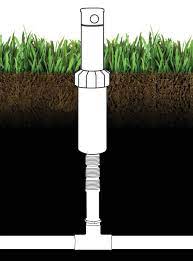
6. How much pressure do pop-up sprinklers need?
This is 20M to 35M head
7. Can you mow over pop-up sprinklers?
Yes you will mow over it, but have the motor off

A pop up sprinkler timer installed for a project at Vipingo, Kilifi county
Micro Sprinklers In Kenya
Micro sprinklers in Kenya by Grekkon Limited are low-pressure, low to medium volume irrigation equipment that are ideal for micro-irrigation. They deliver water directly to the crop root zone, in a uniform manner. They provide full scale surface irrigation, and localised watering of crops. Micro sprinklers are used for; fruit tree, lawn, hedge, and small garden irrigation
Micro sprinkler price in Kenya
The unit cost of all types of sprinkler jet micro sprinklers at Grekkon Limited is from Kes 100 at any of our branches nationwide. Micro sprinkler price per acre is a factor of the number of units used, which depends on the crop spacing. For instance tree tomato spaced at 2M x 2M will require a higher number of micro sprinklers than avocado spaced at 6M x 5M
Each unit is composed of 3 parts; the sprinkler, the 8mm diameter connecting tube, and a 1-1/2′ long plastic support stand
Micro sprinklers save water through high application efficiency, and uniformity of spray. They are a substitute for button drippers where drip irrigation is impractical, but create a larger wetted area than drip irrigation. Micro sprinkler irrigation provides low precipitation which allows for longer watering time with low run-off. They are available in a wide range of plastic configurations. Micro sprinkler sets are used with fertigation systems which save on fertiliser application labour cost. They are also light in weight and small in size, which makes them highly portable, and easy to install
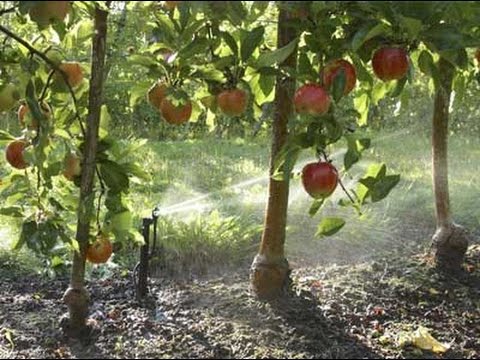
Micro sprinklers watering an apple crop
What is micro sprinkler irrigation?
It is micro irrigation through the adoption of sprinkler jet micro sprinklers, set at the base of the plant
Micro Sprinklers In Kenya
Coverage:
Micro sprinklers coverage is a factor of; flow rate, wetting diameter or radius, and the wetting degree.
1. Operating pressure; from 15M head / 1.5 bar – 20M head/ 2 bar. Pressure lower than this will cause the micro sprinkler to release large droplets, or cease rotation. These droplets will be unhelpful, or even destructive to the work undertaken
2. Flow rate 40 litres per hour
3. Irrigation degree; available as 90, 180, and 360 degrees
4. Irrigation dimeter; 1.5M to 3.5M. This is an important factor to note during installation because it guides on the spacing of one sprinkler jet micro sprinkler to another
Micro sprinklers work when positioned upright, or upside down. Upright when they’re standing on the ground for normal irrigation. Upside down when set in a greenhouse, or open field crop to provide humidity to a mature crop or seedlings. This upside down placement is also for keeping plant foliage moist, or for overhead irrigation.
They deliver irrigation water through micro tubing to a series of nozzles attached to risers. They have small to medium sized droplets with good uniformity of coverage, and lower precipitation rate.

How to space micro sprinklers
Micro sprinklers placement is in such a manner that the sprays overlap. If for instance the irrigation diameter is 1.5M, the distance between micro sprinklers will be 2.25M. This ensures that there are no dry spots in between. An overlap ensures full coverage particularly for lawns, hedges or very closely spaced crops
How to use micro sprinklers with fruit trees
Our micro sprinklers for orchards are installed this way: Set one micro sprinkler per tree, 30cm or 1 foot from the base of the tree trunk being irrigated. Unlike online or button drippers which work well with gravity, a water pump will be necessary when irrigating with many micro sprinklers. This is because they need an operating pressure of 15M – 20M head, which is best achieved by a water pump

How much water do micro sprinklers use?
They use a maximum of 40 litres per hour
Micro Sprinklers In Kenya
FAQs
1. How effective is micro sprinkler irrigation?
It reduces water usage by 25% to 40% compared to impact or rain gun sprinkler irrigation, and by 45% to 60% when compared to surface irrigation. They provide uniform water application which ensures uniform growth and crop maturity
2. How far apart should sprinkler jet micro sprinkler be?
It should be less than the radius of their spray. See details above under the heading how to space micro sprinklers
3. When do you use a micro sprinkler?
Like drip irrigation, they are great for water conservation. However, unlike drips they create a humid micro climate around the crop, which is important in the control of certain pests such as spider mites, arphids, and thrips,
4. What are the disadvantages of micro sprinkler irrigation?
4.1. The tubes get clogged more easily than those of an impact sprinkler or rain gun sprinkler. This is because they are much smaller than those of other sprinkler types
4.2. They are more expensive to install than drip lines, or button drippers
4.3. They require higher operating pressure than drip lines, or button drippers, hence the need to invest in a water pump
4.4. They require a higher level of expertise during installation than button drippers, or drip tapes
4.5. The rate of water loss due to evaporation is higher than with a button dripper, or drip irrigation system
4.6. Many units are required per unit of land compared to other larger sprinklers
5. How do micro sprinklers work?
They have micro tubings which deliver water to small openings that release it at a slow rate, as fine particles. They apply water directly to the soil surface allowing it to percolate under low pressure
6. How far do micro sprinklers spray?
1.5M to 3.5M diameter
7. What are the components of a micro-irrigation system?
7.1. A pumping station to provide the right pumping pressure
7.2. A filtration system to capture any debris or dirt that will clog the system
7.3. Mainlines. These are the pipes originating from the pumping station, and feeding the sub-main lines. They are the largest pipes
7.4. Sub-main lines. These are the pipes origination from the main lines, and feeding the laterals. They are smaller in diameter than the main lines
7.5. Laterals. These the pipes connecting to the sub-main lines, to which the micro sprinklers are attached. They are the smallest pipes in diameter
These pipes will be either be of the high density polypropylene (HDPE), or poly vinyl chloride PVC type
7.6. Hydrants. These are the irrigation control units in the field from which water is channelled to various blocks
7.7. Venturi system. This is a chemigation and/or a fertigation unit connected to the main line. It is the point from which soluble fertiliser and drenching pesticides are fed into the irrigation system
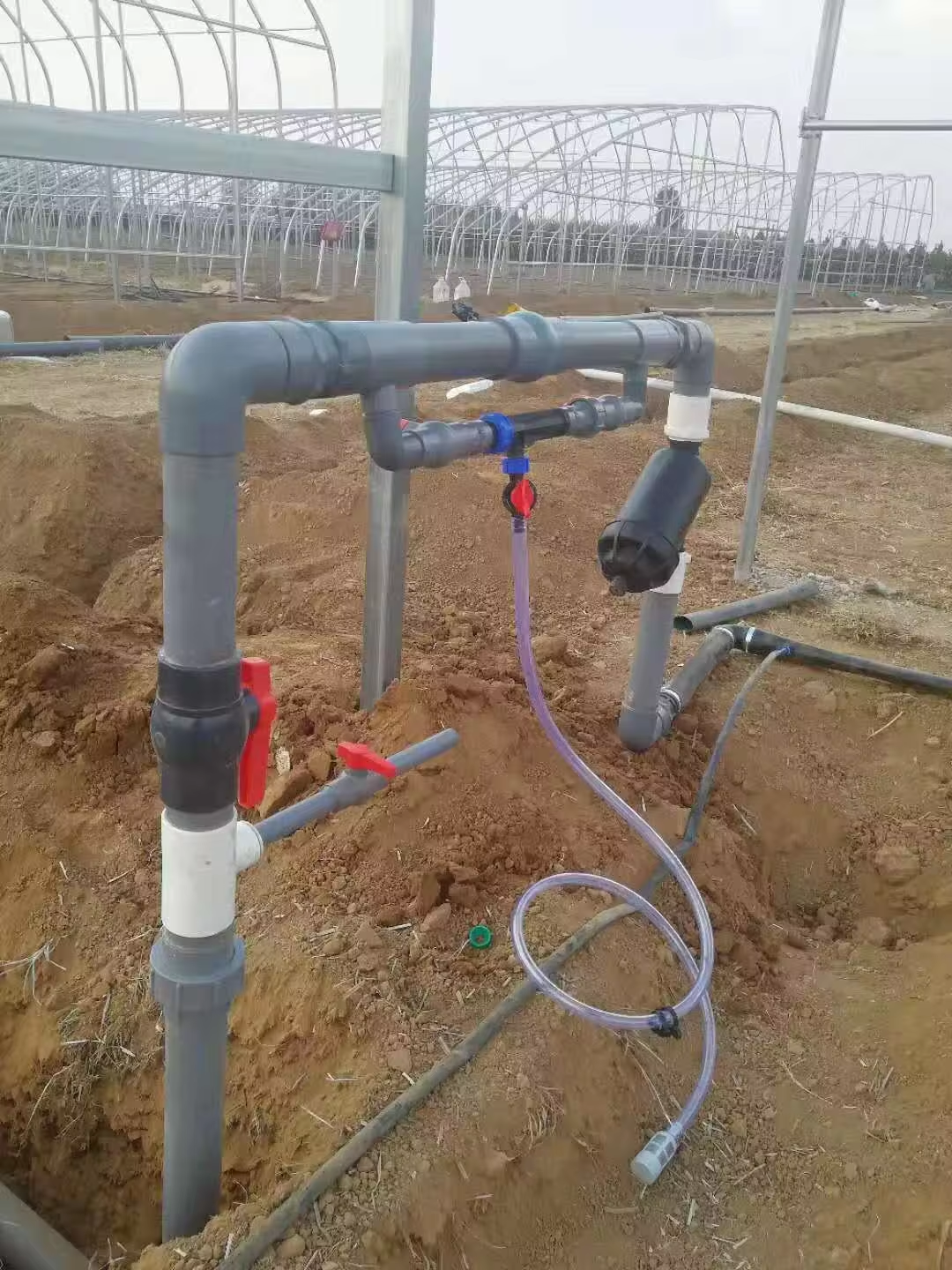
A venturi fertigation – chemigation unit being set up in an upcoming vegetable farm by Grekkon Limited
7.8. The sprinklers. They water the crops directly
8. How long to run micro sprinklers in Kenya?
35 to 45 minutes is sufficient time at optimal flow rate and working pressure
9. What is the difference between drip irrigation and micro sprinklers?
Drip irrigation is for closely spaced crops that require targeted irrigation. Micro-sprinkler irrigation is for sparsely spaced, larger crops or crops that grow best under overhead irrigation
10. What is the difference between mini and micro sprinklers in Kenya?
Mini sprinklers are larger, with a greater flow rate and operating pressure to cover a bigger area. They are better for smaller plants or landscape irrigation
